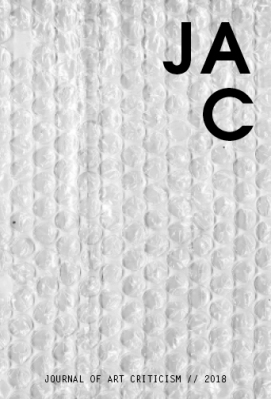 Surface Tension
Surface Tension
For the third edition of JAC, writers and artists rethink surfaces—material as surface, body as container, tactility of surfaces, and surfaces as screens or as tools for masking. What role do surfaces play in a work of art? How might identities and lived experiences be embodied externally? How do artists reveal things that are hidden by surfaces?
In the essays and artworks published in this edition, our contributors consider sociopolitical tensions embedded within surfaces. Using material manipulation, as well as both personal and anonymous vernacular archives, Shelby Ragsdale reexamines the role photography has played in constructing images of a mythic American identity. Natalie Edwards writes on Diana Al-Hadid’s engagement with ruins in her sculpture, Nolli’s Orders. Often framed as a reminder of destruction, Edwards reimagines the ruin as a site where residues from converging cultures endure despite increasingly precarious conditions. Jasmine Weber appropriates glamorized World War II pinup dolls by collaging them onto idyllic landscapes and applying a layer of black paint to their skin. Rendering them unmistakably black, faceless, and conformed to Eurocentric beauty standards, Weber critiques the lack of diverse representation and objectification of black women’s bodies in popular media.
The body can also be considered a surface onto which external forces assign meaning. Carina Hardy constructs a monumental eco-inflatable installation from 3D scans of a woman’s breasts, and in doing so, rejects the policing of bodies in public spaces. Tina Shan argues that Ren Hang’s photographic composition of nude bodies evades categorization, making room for more fluid states of being and blurring boundaries of gender and sexuality. Writing on Vaginal Davis’ recent exhibition, “Chimera,” Aaron Su proposes that her painted portraits of famous women of color provide a blueprint for understanding identities as unstable, porous, and permeable. Su draws on the idea of the chimeric subject to gesture towards the potential for bodies to exist outside of definition and to find agency in the non-normative.
Perhaps the most literal take on the surface as an art historical tool is through material significance. Cami Dominguez explores how film frames memory and female identity through hand processed acts of layering, cropping, and repetition. Employing digital embroidery, Ella Viscardi traces the input of data and output of design by leaving visible trails of thread which reveal the mechanical production of the artwork. Anastatia Spicer illustrates John Paul Morabito’s series, “Frottage,” to discuss how textiles translate the relationship between the artist’s hand, matter, and technology. Understanding textiles as surfaces that record their interactions with other bodies and substances, Spicer suggests that these weavings provide a uniquely intimate experience for both artists and viewers.
In gratitude to our own community, the editors would like to thank Joan Snitzer, Mira Dayal, Elisa Wouk Almino, Julia Wolkoff, and the Barnard College Art History department for their generous support and guidance.
Contents:
Shelby Ragsdale
Carina Hardy
Nolli’s Orders: Form Unlimited
Natalie Edwards
Cami Dominguez
Tina Shan
Input Output I and Input Output II
Ella Viscardi
Fibrous Depths: John Paul Morabito’s Woven “Frottage”
Anastatia Spicer
Jasmine Weber
Aaron Su
